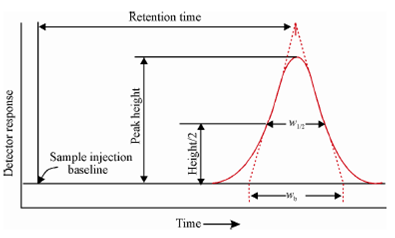Typical chromatogram:
Movement of the solute down the column is then assumed to take place as stepwise transfer of equilibrated mobile phase from one plate to the next. For an efficient separation, we want more such transfers that are more number of plates. This amounts to the fact that the height equal to theoretical plates (HETP) should be minimum. Figure shows a Gaussian elution band and the parameters which are used to calculate N. Retention time (tR)

Figure: A typical chromatogram showing retention time, peak height and band width for estimating the number of theoretical plates
The retention time tR is the time taken from the injection of sample to the appearance of the peak of the elution band at the detector. A formula used to compute N is
N =16 ( t R / Wb ) 2
Tangents to the band are drawn at the two inflection points and the width, Wb, is the distance between the intersections of these tangents with the baseline. The other way is in terms of W1/2, the width measured halfway among the baseline and the top of the band
N = 5.54 (t R/ W1/2) 2
The two methods give comparable results and the choice is a matter of personal preference. For the purpose of determining N, the units for abscissa make no difference. Although tR is defined but actually may be measured on a the recorder chart in cm or mm. In fact, tR and W, should be measured in the similar units.
It should be kept in mind in which the number of theoretical plates in a column is function of column preparation, the features of the solute, flow rate, temperature, method of sample introduction and so forth. However, the number of plates in a column is found to vary with the sample size in a regular way. Overloading of column deteriorates the performance of the column. As a result of this entire N is only an approximate number that is useful for comparative purposes.
In a nutshell, the plate concept only successfully explains the Gaussian shape of the chromatographic peaks and their rate of movement down a column. It fails to explain peak broadening in a realistic way. A concept, somehow, provides an impression that the column contains plates where equilibrium conditions exist. Actually, the equilibrium can never be visualized when the mobile phase is in constant motion.